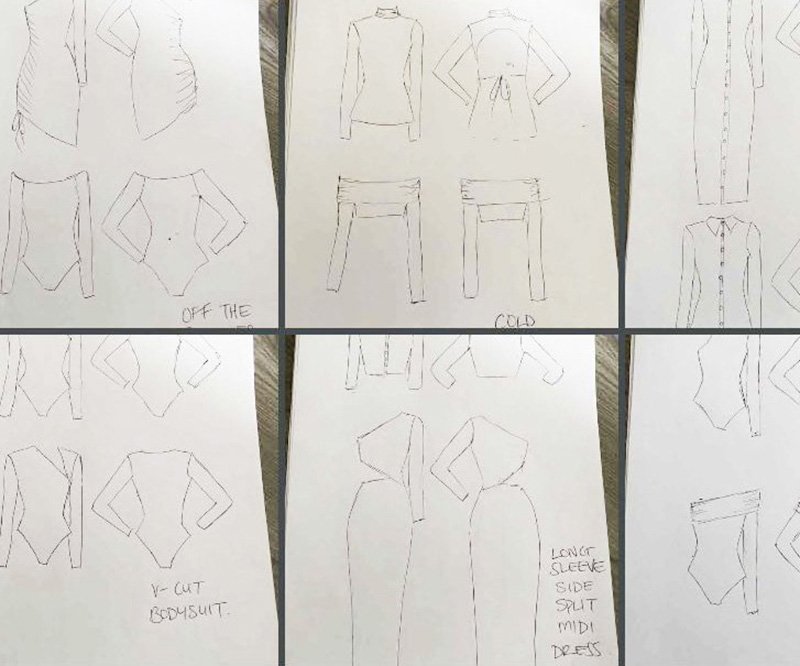We can begin creating the products once the collection’s concept has been decided. Some designers prefer to sketch out their ideas and illustrate their designs, while others prefer to use the model-and-drape method, which entails pinning and draping the cloth on a mannequin to achieve the desired effect. Whatever option you choose, the most critical step is to turn your design into an actual one.
The manufacturing process is a less glamorous aspect of the fashion industry, but it is crucial. Because there are so many processes in production, you’ll want to leave plenty of time and actively monitor the process.
1.Complete the Tech Packs
Prepare tech packets for manufacturers once your design is complete. It’s critical that everything is correct, and that you’ve included every last detail, so the manufacturer knows exactly what you’re talking about.
Important things to think about when designing:
– Purpose – What is your product’s purpose? Is there a set time when you should utilize it?
– Silhouettes — Draw your drawings from all angles, including the front, rear, and sides.
– Proportions – This refers to how the designs will appear on the human body.
– Details/trimmings/embellishment – Make a list of all the details, trimmings, and embellishments you intend to utilize.
– Motion – Consider how a design would appear when moving. Is it pleasant to stroll in? Is it going to stifle any movement?
– Fabric — Think about the materials, mixes, and finishes you wish to use.
– Colors/prints – Draw your design in the color or print version that you like.
2.ORDER FABRIC AND TRIM SAMPLES
Order enough yardage for sample production after obtaining fabric and trim, and use it for testing samples or creating samples for the sales representative. Keep in mind that your sample yardage should be the same quality, color, and pattern as your final design.
3.CREATE A PATTERN
The fit is affected by pattern development, so make sure it’s correct. Because pattern creation can be difficult and time-consuming, you may want to seek technical assistance.
4.CONSTRUCT A PROTOTYPE
A prototype is a sample that has all of the correct design elements, such as the silhouette, proportion, and details like pocket position and size. Because sample yardage is usually not available at this stage, the prototype is constructed with a substitute fabric that is comparable to the original cloth.
5.CREATE A SAMPLE OF FITNESS
A fit sample is typically constructed using sample yards from the completed prototype. The garment will be worn by a fit model so that you can acquire the proper fit and finish your pattern.
6.SELECT THE FINAL COLLECTION OF SAMPLES
Calculate each design’s anticipated cost based on prototype production. Remove styles that aren’t a good fit for your collection and styles that are too time- and money-consuming to make.
7.RECEIVE ORDERS AND SET UP PRODUCTION
To confirm your orders and calculate manufacturing quantities, start pre-selling or delivering your sample outfits to various showrooms and trade events. Before you begin manufacturing, double-check that all orders have been verified.
8.IMPROVEMENTS TO YOUR PATTERN
A pattern maker will grade the design in all of the sizes available in your line.
9.MAKE A SAMPLING GARMENT FOR PRE-PRODUCTION
After you make an order, the manufacturer creates a pre-production (PP) sample. It’s critical that it’s correct because it’s the manufacturer’s reference for mass production.
10.PROCESS WITH BULK PRODUCTION NOW
The firm will begin mass production after the samples have been approved. If you are unable to handle the production yourself, a production manager should be hired to oversee the process.
11.EXECUTION OF A QUALITY CHECK
If at all possible, conduct quality control inspections at each level of the process. It should not be authorized if it does not match your requirements. The sooner you recognize quality issues, the less money and time you’ll lose later.
12.SHIPPING AND PACKAGING
When it comes to packaging and shipping, buyers frequently have precise instructions and preferences.
If you don’t follow the purchasers’ instructions and ship on time, they may deny your items and charge you chargeback fees.

